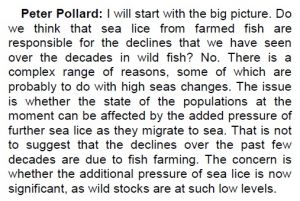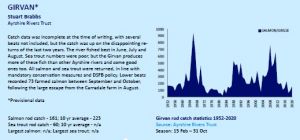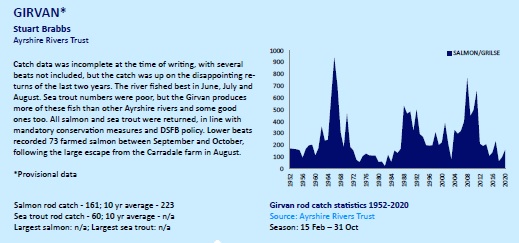Wild Strategy: Fisheries Management Scotland (FMS) have now posted the presentations from their recent annual conference on their website and are available to view at http://fms.scot/2021-conference-presentations/
I attended the conference on the day and found there were a number of issues that merit further discussion. The following is part of a slide taken from the presentation given by Dr Alan Wells, Chief Executive of FMS that highlights a wild salmon crisis.

The slide appeared after 9 minutes of the 15-minute presentation, which begs the question that the wild salmon crisis cannot be so much of a crisis if it did not warrant mention at the beginning of the presentation, let alone at the beginning of the conference. As the slide indicates, Dr Wells says the wild salmon crisis is widely recognised. I am not sure I would agree. If wild salmon were in crisis, then where are the headlines (certainly not in the new FMS annual review) and where are the demands for immediate and radical action. They were certainly not very apparent during the conference where it all seemed rather laid back.
The second presentation of the day came from head of the Freshwater Fisheries Laboratory, Dr John Armstrong, who indicated that wild salmon have experienced some declines, but he never mentioned the word crisis at all.
Dr Wells continued his presentation with reference to the 12 pressures identified as impacting wild salmon, saying more needs to be done. I disagree and I do so because I think they are simply a distraction. In his presentation, Dr Armstrong clearly stated that climate change is the driver of the decline, yet climate change does not feature in the list of pressures. Dr Armstrong also said that multiple other factors affect salmon and not all may yet have been identified, so why is the focus restricted to just these 12 pressures?
Dr Wells may suggest that more needs to be done on the 12 pressures, but the emphasis is not equal. Besides poaching, which has always been a priority for fisheries managers, the only other internal committee listed by FMS is their fish farming committee. FMS also have the services of a fish farming interactions manager, but no manager in place for the other pressures.
FMS tweeted this week that man made barriers remain one of the biggest impacts to fish populations, yet Scotland’s River Basin Management Plan published in 2015 expects that 87% of water bodies will be of good ecological status by 2027. Perhaps, the services of a barrier manager might have helped force through improvements long before then. Instead, many of thousands of pounds are being paid for a manger whose maximum impact could only ever affect just 10% of the Scottish salmon stock. Clearly, the priorities are all wrong.
What’s most interesting about the 12 pressures concerns the listed pressure of exploitation and especially to exploitation by rod and line. The only explanation of what is being done to investigate this pressure is reference to “A Marine Scotland funded, 3-year PhD on rod & line catch and release mortality commenced in October 2018.”
The assumption would be that there could be a risk to wild salmon from catch and release which should be quantified, hence the need for this study. At present, Marine Scotland appear to be hanging on tightly to their findings. Meanwhile, DFO in Canada have issued recommendations for catch and release of Atlantic salmon. They recommend that anglers should refrain from catch and release when water temperatures reach 18oc as mortality rises sharply above that temperature. In Newfoundland, one study found that at 20oC only 20% of the salmon survived after release. Given the higher temperatures reported around Scotland, refraining from catch and release would mean that all fishing should stop when water temperature rise.
However, the reality is that this Marine Scotland study about catch and release simply deflects attention away from the fact that recreational angling using rod and line appears not to be considered one of the pressures affecting wild salmon, even at this time of crisis. Of course, this is not surprising as the angling fraternity have always denied the decline of wild salmon stocks has little to do with them.
Dr Wells also referred to the Wild Salmon Strategy, which has yet to reach its conclusion. I understand that there has only been one meeting so far in 2021, so seemingly no crisis for this group either. The minutes of the first meeting held on 30th October 2020 have recently been published and there is no mention of this crisis. Instead, one contribution to the group discussion was that “The mental health and wellbeing aspects of angling became clear during lockdown and should be considered in the strategy.” Clearly, wild salmon are not in such a crisis that justification can be made to continue catching them to help the mental wellbeing of anglers.
The minutes of the second meeting (4th December 2020) have also just reached me and again one contribution to the group discussion caught my attention. This was that there should be consideration as to whether inshore fishing equipment is endangering salmon. I can only read this with despair. The wild salmon angling sector have managed to blame everyone from netsmen to canoeists; from salmon farmers to high sea fishing; from rafters to wind farms and now they seem intent on turning their attention towards the inshore fishing industry. When will the wild salmon sector stop blaming everyone and anyone and start to accept some responsibility themselves? They are the ones that have caught and killed 5.9 million wild fish from Scottish rivers since records began in 1952. This was their responsibility, not that of anyone else.
The angling fraternity worked hard to close down commercial netting in Scotland and yet wild salmon numbers continue to decline. Although I know that the wild fish lobby is so powerful that the following suggestion will be dismissed out of hand, but in the same way that commercial netting was initially curtailed with a three year ban, perhaps, recreational fishing for salmon and sea trout should also be banned for three years to see the impact on stocks. I know that this suggestion will never be considered, so I would like to explore an alternative route to safeguarding wild salmon.
The meeting minutes also confirm that the Wild Salmon Strategy group consists largely of the ‘usual suspects’ who undoubtedly will talk about the same proposals that have been heard before. I do not expect any radical and immediate solutions to be put forward in any forthcoming strategy and whilst the ensuing strategy will eventually be sent out for consultation, it will be a consultation on the group’s proposals, not a search for new solutions. With this in mind, these are some of my own thoughts:
- The creation of a single salmon angling season that runs from 15th May to 15th October covering all of Scotland.
- All salmonid fishing is mandatory catch and release. Any fish inadvertently killed should be frozen and retained by the proprietor to be sent to Marine Scotland Science for scientific research. No wild salmon should be consumed.
- The netting loophole that allows estuary fishing should be closed so all netting is illegal.
- All anglers fishing in Scotland must purchase a rod licence to help fund protection of wild fish.
- All anglers fishing in Scotland must (pay for) and attend a fish handling course to ensure strict adherence to catch and release regulations.
- Any rivers below conservation limits should be closed to fishing for the season.
- Counters should be sited on all salmon rivers in Scotland that are fished.
- Rivers that have SAC status should not be entered on foot to safeguard the protected habitat. All fishing should be conducted from the bank or boat and not by wading.
I look forward to reading about these ideas in a future meeting minutes, but I won’t be too surprised to see that they are totally ignored.
Aquaculture Interactions: Another conference presentation came from Salmon Interactions Manager Polly Burns. Her presentation was titled ‘Changing the Conversations’ and I looked forward to hearing something new and different, but sadly the conversation did not change at all and delegates were exposed to the same old rhetoric that wild salmon need to be protected from salmon farming.
Before I discuss a couple of aspects of her presentation, I would mention that during the conference Q&A, I asked Polly to respond to SEPA’s Peter Pollard’s comments to the REC Committee that salmon farming was not responsible for the decline of wild fish in Scotland. Polly’s answer was to read out the whole of Peter’s statement. This is copied below:

I think she was trying to stress the point that stocks are so low that they should be protected from any pressure, no matter how small. However, I would like to offer a different interpretation to her comment:
Salmon farming is not responsible for the decline in wild fish, but whilst wild salmon have been under our management and care, stocks are now in crisis. We want to make sure that even the smallest impact due to salmon farming is minimised. This is despite the fact that in 2019, the last year for which data is available, we oversaw the killing of 528 wild salmon and sea trout for sport caught from rivers within the aquaculture zone.
So, whilst salmon farming is asked to suffer the imposition of more stringent regulation, even though the industry is not responsible for the declines, anglers are not being asked to show similar restraint and curtail their habit of killing wild fish for their own pleasure. As I pointed out previously, despite a wild salmon crisis, the killing continues because as everyone knows, the crisis has nothing to do with angling.
In her presentation Polly referred to the Salmon Interactions Working Group report and made a point of saying that the participants came to a unanimous agreement for a better regulatory system for the protection of wild fish. Yet, whilst the participants may have agreed to all the recommendations, there are some major unresolved questions such as Peter Pollard’s comments to the REC Committee. Given that Peter sat on the group, why was the actual interactions between farmed and wild salmon never discussed. My understanding that the intention of the group was not to discuss the actual interaction but to only focus on solutions. Certainly, the group repeatedly rejected offers to hear alternative views. This is why we are now in a situation where we are considering the imposition of the most stringent regulations intended to protect wild salmon from something that has just a minimal impact.
However, this is all now irrelevant because the SIWG recommendations should now be considered null and void. The salmon farming industry have seemingly signed up to something on which the wild salmon sector cannot deliver. Polly described how under the proposed changes, when a farm is approved, the licence conditions would continue to apply during its operation to ensure that it doesn’t have any impact on local wild fish stocks. Unfortunately, new rules brought in by Marine Scotland Science last year mean that catch data for many west coast rivers is no longer available for consultation by the salmon farming industry even though SIWG was supposed to open up access to more data.
To use the example of the River Ewe, which is a Grade One salmon river and in probably the most contentious fishery district in Scotland. The 2018 catch statistics were the last data set to include the Ewe system as a separate entity. It is now combined with two other fishery districts so any interest in knowing whether Loch Maree sea trout have recovered after closure of the Loch Ewe salmon farm is denied, except to the scientists at Marine Scotland!!
At the same time, FMS dropped the Ewe system catch data from their Annual Reviews so the 2018 data is the last they included. The Ewe system is not unique in this regard. Many other west coast fishery districts have ceased to exist in terms of catch data reporting. The reality is we need more data, not less. For example, when conservation limits were first introduced, they applied just to the existing fishery districts. However, local anglers complained that their river was of a higher conservation status than others in the district and therefore should be assessed separately. This means that there are now many more assessments then previously undertaken and each has to be calculated from the catch data. It therefore makes sense that if anglers see their river as a distinct entity, the catch data for that river should be made available for consultation, not concealed as it is now.
I would also point out that FMS have just published their 2021 Annual Review. This includes the usual river reports. However, eight reports are based on provisional or estimated data including the North Esk, Don, Girvan and Stinchar. How can it be that with a season end of October that all the data has not been submitted for a report published towards the end of March? And yet, the wild sector expects salmon farmers to submit their data weekly. In the case of the Girvan, it seems that the local trust was too busy trying to collect data to implicate a local salmon farm to chase up local proprietors. They certainly managed to get the escaped salmon numbers submitted quickly enough, even if nearly 40% turned out to be wild fish and not escaped fish at all.

Why is the availability of accurate data important? Simply, catch data has shown that in many cases, there is no connection between the numbers of salmon in local rivers and nearby farms. I would have pointed out this to SIWG, but they were not interested in hearing about such things.
Finally, I would like to refer to one other issue raised by Polly Burns. She said that one of the other things to come out if SIWG was a spatial planning model for consenting. This is a tool which is designed to inform planners of areas of high risk in relation to the impacts on wild fish and areas where development can continue in a sustainable fashion.
Yet, as we know because Peter Pollard told the REC Committee, salmon farming is not responsible for the decline in wild fish so there should be no areas of high risk, because if salmon farming is not responsible for the declines then there can be no or little risk.
Rumours have been in circulation for some time about this model. Seemingly FMS know more about it than Polly revealed. It is a subject that I would like to discuss in more detail in a future reLAKSation as there are parallels with the Norwegian Traffic Light system. Perhaps, if anyone would like to share any information in confidence, their input would be extremely welcome.
Polly’s presentation – https://www.youtube.com/watch?v=6oHAjk6FOQ8&t=43s
Pee, poo and paper: The Ferret has reported that Scottish Water discharged sewage on over 500 occasions into the River Almond during 2019. The sewage was released through Combined Sewer Overflows that act to relieve pressure on the sewer network during heavy rainfall. However, along with the flood water, waste flushed down toilets is also released.
The Forth Rivers Trust said that they had collected over 1300 items of litter along one 100 metre stretch of the river of which 90% was wet wipes or flushed material. Scottish Water have urged residents to only flush the three Ps Pee, Poo and (loo) Paper.
In response there has been no comment forthcoming from any of the salmon conservation organsiations. Instead, Fisheries Management Scotland have urged Scottish election candidates to help save wild salmon. They are asking candidates to commit to three vital measures.
Making salmon a national conservation priority
Funding the planting of native trees
Implement the recommendations of the Salmon Interactions Working Group
It seems that FMS are so focussed on targeting the salmon farming industry that they remain oblivious to the pollution regularly flowing down some of their local rivers.

